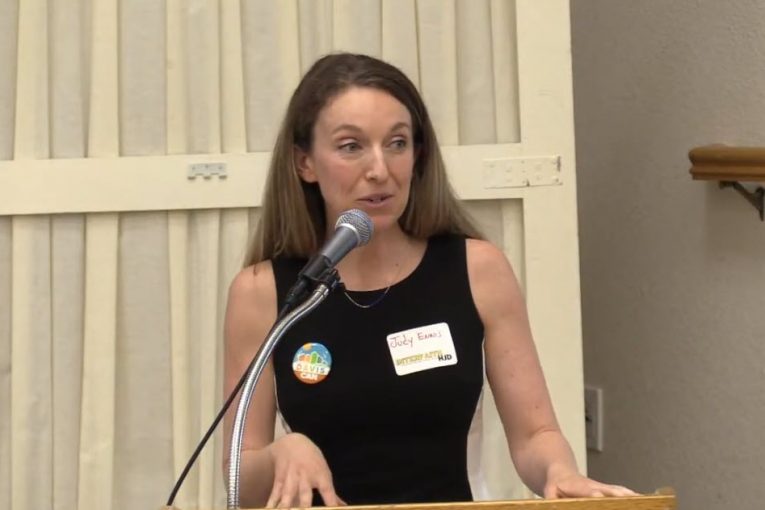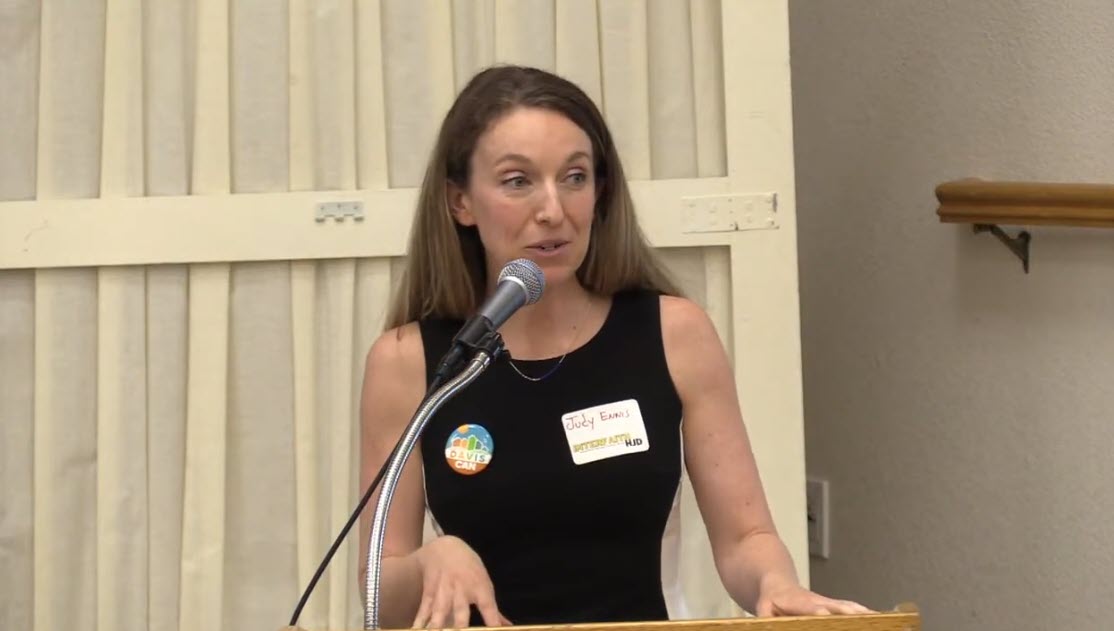

Editor’s Note: On Thursday, Interfaith Housing Justice of Davis presented “Davis Housing Solutions: A Community Conversation” – a forum at the Davis Community Church. What follows are the full comments by Judy Ennis – Executive Director of DCAN.
Full comments by Judy Ennis
My name is Judy Ennis. Thank you so much, mayor Chapman for the introduction. I’m the executive director of Davis Community Action Network and I’m very proud to be here tonight with all of you. When I was invited to speak, the question that was posed to me is do we have enough housing and is it affordable? And I joked at the time, no, but that simple answer doesn’t tell the story. And so what I’d like to do in the tight five  minutes that I have, so I’m going to be talking fast, so please excuse me, is instead dig into that. No. We’re going to talk a little bit about the history of our growth in Davis, where we are right now in terms of our housing stock and access to housing, and then transition as Josh just set us up perfectly for to thinking ahead towards how we shift the paradigm for how we add housing and think about housing in the city and in the region. So with that, if you could please
minutes that I have, so I’m going to be talking fast, so please excuse me, is instead dig into that. No. We’re going to talk a little bit about the history of our growth in Davis, where we are right now in terms of our housing stock and access to housing, and then transition as Josh just set us up perfectly for to thinking ahead towards how we shift the paradigm for how we add housing and think about housing in the city and in the region. So with that, if you could please
Picture in your mind. My first question to you is picture home.

Think about the first home that came to mind for you. Was it your current home where you live right now? Perhaps it was the childhood home you grew up in. Maybe it was in a city, maybe you were in an apartment, maybe you were in another country. Each of us has a slightly different picture that just came to mind, but more likely than not, there are aspects in common for all of us of what we think about when we think about home. Perhaps it was when you were a student and you moved to a new place and you found a sense of belonging for the first time in a new community of people that you found to be like-minded. That’s an aspect of home belonging. Maybe it was the first time that you fell asleep in your bed at night and you felt truly safe.

That’s an aspect of home safety beyond those two things, safety and shelter we’ve all shared. That’s a basic of the human experience, but belonging, that’s another piece of the puzzle. And I’m going to add a third. When you think about home, if you could go to the next slide, perhaps the home that you thought of looked a little like this. This is an iconic image and it’s one that is indicative of our history in the last 70 years or so of growth in suburban America. The house that I live in right now actually reflects this because much of Davis actually reflects this. I live in a single family zoned home surrounded by other single family homes with my who are watching tonight, hi boys.

And within this American dream, we know that in the land use patterns that came with this boom, many people were rocketed into a different type of prosperity and many people by design were left out. So if you could go to the next slide, we followed that same pattern that there on the left is us in 1946, small agricultural hamlet sitting between the Bay area and Sacramento. And right here on the right, that’s us today.

That’s just an aerial view of our city right now. Now we followed the fits and bursts of development that other suburban communities followed, which was we did subdivision by subdivision, a burst of 200, a burst of another 200, and then we hit the brakes and we slowed down. And in the last two decades we’ve had about 4.6 growth after 2010, there are pros and cons to that. Here’s a pro, we resisted the urge to expand to sprawl that so many other communities in California did do right?
We have ample green space, we have our green belts, we have our bike paths, and that is a wonderful thing. And the con to it is that because we did not grow, we have also continued to leave people out. So let’s go to the next slide if you could please.

Of all the housing units in Davis, the top reflects Davis, 56% are single family homes and most of them were built after 1980. Alright, on the right hand side there you see that 30% are multiplexes. The apartment buildings that are of higher density within our city, 12% represent condos, townhomes, et cetera. I better hurry up my time’s running out that bottom side.
There’s missing middle housing. That bottom picture is what’s very popular from the book missing middle housing and has gained popularity with urban planners around the country to indicate a variety of dwellings and residential configurations that match a variety of stages of life and socioeconomic levels that reflect a true diversity of a community. And that is what we are missing right now.

We think of ourselves as an affluent community, and it’s true there is significant affluence here in Davis. However, that top number might surprise you based on the census data. We are at 27% poverty, you might say in your mind quickly. Well, that’s because of students. Students are focused on their studies, they’re not earning an income. It’s bringing that number up. However, when you look at the number at the top there, and perhaps for those of you in the back that can’t read it, it shows that for children under 18 years old, we’re at 20% poverty. The average poverty percentage for the state of California is 12.2%. Are we as affluent as we say we are? Please if you could go to the next slide.

Here’s more evidence of that. This is from our housing element. Thank you city of Davis for completing our housing element. This graphic shows what overpayment by homeowners looks like across the neighborhoods in Davis. If you live in Davis, take a moment and find your address on the screen. Now, if you look at it, this means the federal definition of being overburdened in your house payments is that you’re paying 30% or more. That’s the threshold, 30%. What this graphic indicates is that there is not a single neighborhood in Davis where people are not struggling to pay their mortgage varying degrees. Yes, some people are doing well, yes, but with every single neighborhood we have struggle. Please go to the next slide. 55% of our city are renters. Of our renters. The situation is far more dire. The scale here has changed. Where the yellow has moved to 20 to 40%, the previous slide was 10%.

That means that if you were to choose any street in Davis, close your eyes, open them again and pick an address. Chances are the people that you are looking at, the kitchen table that they’re sitting at is one that’s struggling to pay for food because they are overburdened in their housing payments. And I’ll say this point more clearly, we know it’s more than 30% based on this graphic. We don’t know if it’s 75%, we don’t know if it’s 50%, but we know it’s too high.

Next one yet, housing prices continue to rise and vacancy rates stay low. There is a combination effect here. Part of the American dream subdivision planning model that Davis is a part of also includes the fact that we rely on land value and house appreciation as part of our fortune. Having an address that you own, having an address where you rent dictates your fortunes in different ways, and I’m using the term fortune in two different meanings.
Our literal fortune as in our retirement, I’m going to sell this house and it’s going to take care of me. And it also means our fortune in terms of our opportunities for work, our opportunities for school, the friends that you make, the friends that you meet, how far away the grocery store is and what kind of food they sell there. In my career before I shifted to housing, I worked in education. And in that time the lessons of inequity in society as it shows up by zip code was all too real to me every day. And that’s why I shifted to housing is because this reality is what’s shaping the lives of children, families, and seniors, not just in California but nationwide, but it is uniquely concentrated here.

It impacts everyone. Tonight we have in fact been talking about those that are the most vulnerable, but I don’t want us to lose sight of the fact that if our neighbor isn’t doing well, it means our community isn’t doing well. This affects seniors, even those who might be in a four bedroom house and might be from all respects seeming to do quite well but may not be able to pay for their groceries. It absolutely affects children as we already discussed. And we also know that it affects our workforce. 57.9% of uc, Davis employees live outside of Davis. And one of the top reasons that’s cited for that is affordability. There are other colleagues here that are going to be talking about the experiences of students. So I won’t go into detail there, but we know that they are also experiencing higher rates of housing insecurity. If you could please, the good news is at events like tonight, what we’re searching for is a way to shift that paradigm to think about this in a new way. Local action, local partnerships and local solutions work together to find our way out of what this seems to be a box that we’re in right now.

The housing trust fund, which we’re going to be discussing in detail tonight, is one of those examples of public investment, a reflection of our values as a community being used as a lever away from for-profit only development. I’m not saying for-profit only development will go away. No, no. It’s expanding the marketplace to include nonprofit and public oriented development. So I’m very excited to learn from my colleagues on the right of me here and from all of you in the room on how we can make this shift towards funding our housing trust fund in a way that gives us another path forward. And with that, I will leave you. Thank you so much for the time.

